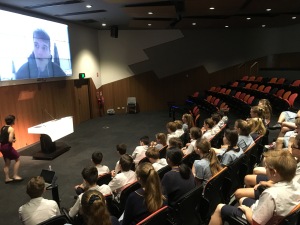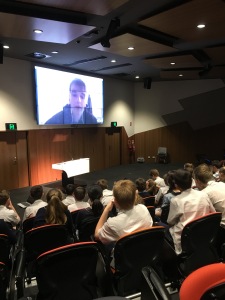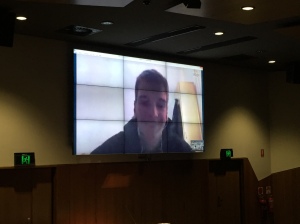Why should educators be connecting their students globally?
What literature, research and opinions can you gather and synthesise to support an argument for this?
Before I reply, let me share with you this infographic I found:

(Britt, 2001)
If we take a look at this infographic, what are your initial thoughts about the way technology is going?
Every minute millions of people are using the internet and digital technology in some way - some for personal use, some for work, some for connecting with others. In a 21st Century, we need to be teaching our students how to globally connect and the skills associated with these. We are living in an ever increasing digital and globally connected world, and our students need to be literate members of it.
I want to focus on the skills associated with living and working in the 21st Century.
As we can see from this table from Fishtree EdTech, the skills required by a 21st Century member of society link to being globally connecting. In particular, it is essential for members of a 21st Century society and workforce to have a cross-cultural understanding and be able to effectively communicate, not just with people in their direct community, but with all others involved - whether it be within the company, or internationally. Collaboration needs to extend beyond 'group work' in the classroom, and start making authentic connections with real-life situations, that is, collaboration with students, teachers and information from around the world.
Globally Connecting - Why we should do it
Globally connecting provides exciting opportunity for students, especially when teamed with Project-based Learning (PBL). It gives students an opportunity to practice these essential 21st Century learning skills, but also engage with other ‘real people’ and sources - and form emotionally engaging and authentic connections to what they are learning.
“We know from neuroscience that in order for kids to learn something, they need to have an emotional connection to the content,” says Michael Soskil, head teacher and curriculum coach at Wallenpaupack South Elementary School in Newfoundland, Pennsylvania. “There is no more powerful way to make that emotional connection than by doing good for others. With global PBL, students can identify a problem in the world and work to solve it.”(Connects, 2015)
And you know what? Even workplaces and generally societal means require people to have skills in global connections, along with the other 21st Century Skills:
Michael Furdyk, co-founder and director of innovation at TalkingITGlobal discusses that;
“Given the increasingly global nature of most companies and global challenges, collaboration across countries and cultures will be a critical aspect of our students’ future ability to be productive and successful in their careers.”
(Connects, 2015)
Now how does that relate back to us in our profession? Are we required to be 'globally connected' ourselves? Should we be 'globally connecting' our students? Lets take a look at this list from
Tsisana Palmer, contributor to the
edutopia blog;
This article describes the 15 Characteristics of a 21st Century Teacher:
- Learner-Centered Classroom and Personalized Instructions
- Students as Producers
- Learn New Technologies
- Go Global
- Be Smart and Use Smart Phones
- Blog
- Go Digital
- Collaborate
- Use Twitter Chat
- Connect
- Project-Based Learning
- Build Your Positive Digital Footprint
- Code
- Innovate
- Keep Learning
(Palmer, T., 2015)
From this list we can see that all these attributes that teachers require link somehow to being ‘globally connected’ - a skill that we need to have to be professional educators, and skills we need to pass onto our students so that they may be a well rounded member of a 21st Century workforce and society. We would most certainly be doing our students a disservice if we did not at least attempt toand trying to connect our students globally and guide them through the skills associated with it.
Final Thoughts...
Times are changing.
It's in our faces the whole time, media, social media, the internet, new technological advances... the world is not the same place it was 5, 10, 15 years ago. It is no longer enough to teach students the content from a text book and to tick off a checklist of outcomes. We, as educators, must provide our students with the best opportunities and prepare them to be the best members of society that they can be. And when society is becoming increasingly 'global', we need to prepare them with all the tools we have to fight and succeed in their fields of life.
Bibliography
15 Characteristics of a 21st-Century Teacher (2015) Available at: http://www.edutopia.org/discussion/15-characteristics-21st-century-teacher?utm_source=twitter&utm_medium=socialflow (Accessed: 14 October 2015).
Britt (2001) In an Internet Minute. Available at: http://bwatwood.edublogs.org/2015/01/20/in-an-internet-minute/ (Accessed: 14 October 2015).
Connects, I. (2015) Global PBL projects connect students across continents. Available at: https://www.iste.org/explore/articleDetail?articleid=322&category=ISTE-Connects-blog&article= (Accessed: 14 October 2015).
Connects, I. (2015) Global PBL projects connect students across continents. Available at: https://www.iste.org/explore/articleDetail?articleid=322&category=ISTE-Connects-blog&article= (Accessed: 21 October 2015).
EdTech, F. (2015) ‘The 7 C’s of 21st Century Lifelong Learning Skills http://t.co/VS3MN4PreH #TTOG #cpchat #1to1techat’, Twitter, 24 April. Available at: https://twitter.com/fishtree_edu/status/591715783648116739 (Accessed: 14 October 2015).
Global Connections for Teachers and Students (no date) Available at: http://digitalhumanlibrary.com/connect-with-teachers-and-students/ (Accessed: 14 October 2015).
Yin, L. K. (2011) Learning Journey... Available at: http://lohky.blogspot.com.au/2011/10/apple-learning-journey-nanyang-girls.html (Accessed: 14 October 2015).
(no date) Available at: https://flatteningtheworld.files.wordpress.com/2015/10/how-much-are-the-the-time-achangin_502911b9b2615_w587.jpg (Accessed: 21 October 2015).
Citations, Quotes & Annotations
15 Characteristics of a 21st-Century Teacher (2015) Available at: http://www.edutopia.org/discussion/15-characteristics-21st-century-teacher?utm_source=twitter&utm_medium=socialflow (Accessed: 14 October 2015).
(15 Characteristics of a 21st-Century Teacher, 2015)
Britt (2001) In an Internet Minute. Available at: http://bwatwood.edublogs.org/2015/01/20/in-an-internet-minute/ (Accessed: 14 October 2015).
(Britt, 2001)
Connects, I. (2015) Global PBL projects connect students across continents. Available at: https://www.iste.org/explore/articleDetail?articleid=322&category=ISTE-Connects-blog&article= (Accessed: 14 October 2015).
(Connects, 2015)
Connects, I. (2015) Global PBL projects connect students across continents. Available at: https://www.iste.org/explore/articleDetail?articleid=322&category=ISTE-Connects-blog&article= (Accessed: 21 October 2015).
(Connects, 2015)
EdTech, F. (2015) ‘The 7 C’s of 21st Century Lifelong Learning Skills http://t.co/VS3MN4PreH #TTOG #cpchat #1to1techat’, Twitter, 24 April. Available at: https://twitter.com/fishtree_edu/status/591715783648116739 (Accessed: 14 October 2015).
(EdTech, 2015)
Global Connections for Teachers and Students (no date) Available at: http://digitalhumanlibrary.com/connect-with-teachers-and-students/ (Accessed: 14 October 2015).
(Global Connections for Teachers and Students, no date)
Yin, L. K. (2011) Learning Journey... Available at: http://lohky.blogspot.com.au/2011/10/apple-learning-journey-nanyang-girls.html (Accessed: 14 October 2015).
(Yin, 2011)
(no date) Available at: https://flatteningtheworld.files.wordpress.com/2015/10/how-much-are-the-the-time-achangin_502911b9b2615_w587.jpg (Accessed: 21 October 2015).
(no date)










